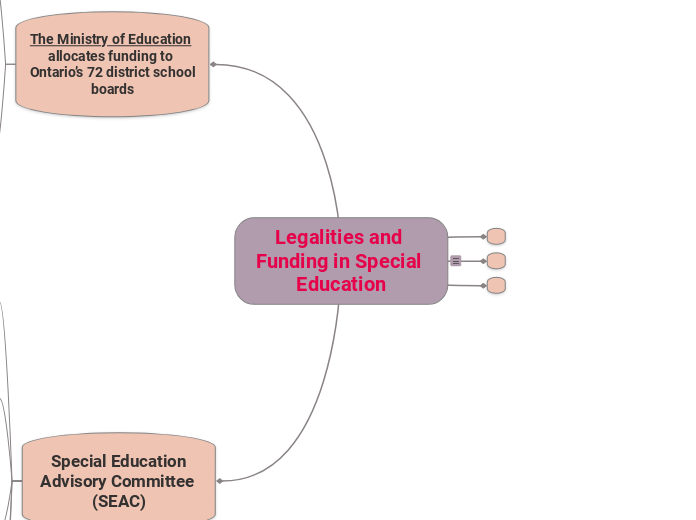Legalities and Funding in Special Education
The Ministry of Education allocates funding to Ontario’s 72 district school
boards
Special Education Grant: for additional costs of programs, services, and/or equipment these students may require. Ther grant is made up of 6 allocations.
1. Special Education Per Pupil Amount Alllocation: provides funding to every school board to assist with the costs of providing additional support to students with special needs and is based on total enrolment of students, not just students with special needs.
Differentiated Special Education Needs Amount Allocation: address the variation among school boards with respect to their population of students with special education needs and the boards ability to support these needs.
Special Equipment Amount Allocation (SEA): purchase of equipment that may be required by students with special education needs (per-pupil amount is for computers, software, robotics, and training AND a claims based process that purchases non-computer based equipment such as hearing or vision supports and physical assist equipment).
Special Equipment Amount.
The Special Equipment Amount allocation is projected to be approximately $140.1 million in 2022-23.
$800 per pupil deductibl
Special Incidence Portion Allocation (SIP): supports students with extraordinarily high needs who require more than two full time staff to address their health and/or safety needs.
The Special Incidence Portion allocation is projected to be approximately $142.0 million in 2022-23.
Education and Community Partnership Program Allocation: g supports school boards’ provision of education programs to
school-aged children and youth in care, treatment or detention facilities.
Behaviour Expertise Amount Allocation: provides funding for school boards to hire board-level Applied
Behaviour Analysis (ABA) expertise professionals, to provide training opportunities that will
build school board capacity in ABA.
Special Education Grant: for additional costs of programs, services, and/or equipment these students may require. Ther grant is made up of 6 allocations.
The Education Act mandates all school boards to provide special education
programs and/or services for students with special education needs
Special Education Advisory Committee (SEAC)
Each school board and school authority must establish a SEAC. hese committees are made up of elected school board trustees and representatives from local associations with an interest in special education
Roles and Responsibilities of SEAC
may make recommendations to the district school board or school authority on anything impacting the establishment, development, and delivery of special education programs and services
may participate in the annual review of the board's Special Education Plan
participates in the board's annual budget process as it relates to special education
reviews the financial statements of the board as they relate to special education
School Board Obligations
make available the personnel and facilities that the board considers necessary for the proper functioning of the committee (for example, personnel and facilities needed to hold meetings using electronic means)
provide SEAC members and their alternates with information and orientation within a reasonable time after a SEAC member is appointed
District school boards and school authorities must provide relevant in-service training sessions for all members during regular SEAC meetings or in an alternative forum on an ongoing basis
In the District School Board of Niagara, the SEAC meeting dates are monthly, and the meeting dates that have occurred this year are: September 14, Oct 12, Nov. 9
Special Education Advisory Committee (SEAC)
